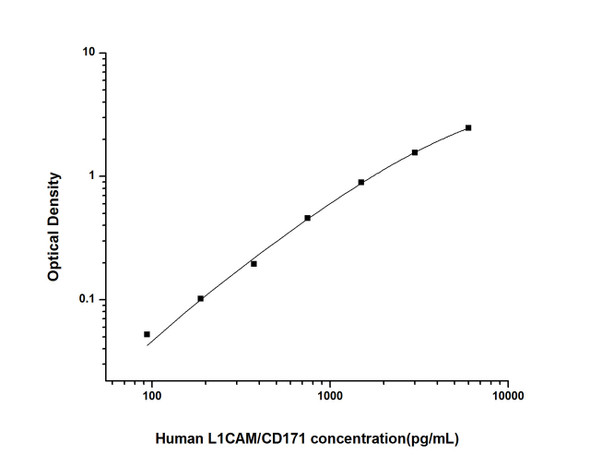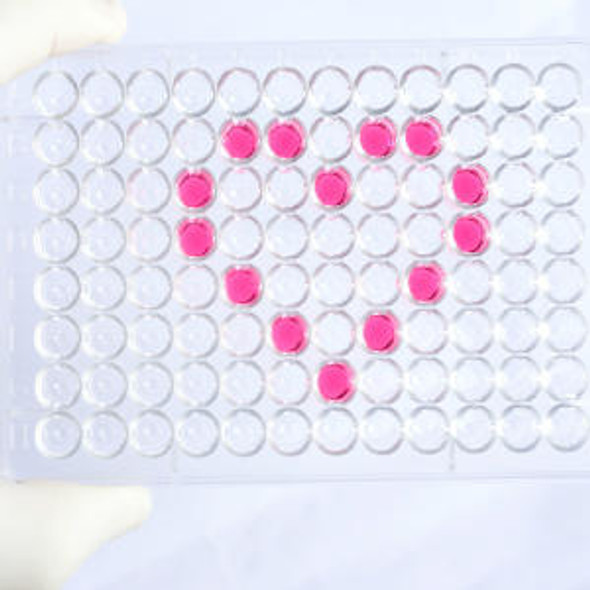Human Cell Biology ELISA Kits 5
Human L1CAM/CD171 (L1-Cell Adhesion Molecule) CLIA Kit (HUES01044)
- SKU:
- HUES01044
- Product Type:
- ELISA Kit
- ELISA Type:
- CLIA Kit
- Size:
- 96 Assays
- Sensitivity:
- 18.75pg/mL
- Range:
- 31.25-2000pg/mL
- ELISA Type:
- Sandwich
- Reactivity:
- Human
- Sample Type:
- Serum, plasma and other biological fluids
- Research Area:
- Cell Biology
Description
| Assay type: | Sandwich |
| Format: | 96T |
| Assay time: | 4.5h |
| Reactivity: | Human |
| Detection method: | Chemiluminescence |
| Detection range: | 31.25-2000 pg/mL |
| Sensitivity: | 18.75 pg/mL |
| Sample volume: | 100µL |
| Sample type: | Serum, plasma and other biological fluids |
| Repeatability: | CV < 15% |
| Specificity: | This kit recognizes Human L1CAM/CD171 in samples. No significant cross-reactivity or interference between Human L1CAM/CD171 and analogues was observed. |
This kit uses Sandwich-CLIA as the method. The micro CLIA plate provided in this kit has been pre-coated with an antibody specific to Human L1CAM/CD171. Standards or samples are added to the appropriate micro CLIA plate wells and combined with the specific antibody. Then a biotinylated detection antibody specific for Human L1CAM/CD171 and Avidin-Horseradish Peroxidase (HRP) conjugate are added to each micro plate well successively and incubated. Free components are washed away. The substrate solution is added to each well. Only those wells that contain Human L1CAM/CD171, biotinylated detection antibody and Avidin-HRP conjugate will appear fluorescence. The Relative light unit (RLU) value is measured spectrophotometrically by the Chemiluminescence immunoassay analyzer. The RLU value is positively associated with the concentration of Human L1CAM/CD171. The concentration of Human L1CAM/CD171 in the samples can be calculated by comparing the RLU of the samples to the standard curve.
| UniProt Protein Function: | Neural cell adhesion molecule involved in the dynamics of cell adhesion and in the generation of transmembrane signals at tyrosine kinase receptors. During brain development, critical in multiple processes, including neuronal migration, axonal growth and fasciculation, and synaptogenesis. In the mature brain, plays a role in the dynamics of neuronal structure and function, including synaptic plasticity. |
| NCBI Summary: | The protein encoded by this gene is an axonal glycoprotein belonging to the immunoglobulin supergene family. The ectodomain, consisting of several immunoglobulin-like domains and fibronectin-like repeats (type III), is linked via a single transmembrane sequence to a conserved cytoplasmic domain. This cell adhesion molecule plays an important role in nervous system development, including neuronal migration and differentiation. Mutations in the gene cause X-linked neurological syndromes known as CRASH (corpus callosum hypoplasia, retardation, aphasia, spastic paraplegia and hydrocephalus). Alternative splicing of this gene results in multiple transcript variants, some of which include an alternate exon that is considered to be specific to neurons. [provided by RefSeq, May 2013] |
| UniProt Code: | P32004 |
| NCBI GenInfo Identifier: | 1705571 |
| NCBI Gene ID: | 3897 |
| NCBI Accession: | P32004. 2 |
| UniProt Secondary Accession: | P32004,Q8TA87, A0AV65, A4ZYW4, B2RMU7, G3XAF4, |
| UniProt Related Accession: | P32004 |
| Molecular Weight: | 138,908 Da |
| NCBI Full Name: | Neural cell adhesion molecule L1 |
| NCBI Synonym Full Names: | L1 cell adhesion molecule |
| NCBI Official Symbol: | L1CAM |
| NCBI Official Synonym Symbols: | S10; HSAS; MASA; MIC5; SPG1; CAML1; CD171; HSAS1; N-CAML1; NCAM-L1; N-CAM-L1 |
| NCBI Protein Information: | neural cell adhesion molecule L1 |
| UniProt Protein Name: | Neural cell adhesion molecule L1 |
| UniProt Synonym Protein Names: | CD_antigen: CD171 |
| Protein Family: | Neural cell adhesion molecule |
| UniProt Gene Name: | L1CAM |
As the RLU values of the standard curve may vary according to the conditions of the actual assay performance (e. g. operator, pipetting technique, washing technique or temperature effects), the operator should establish a standard curve for each test. Typical standard curve and data is provided below for reference only.
| Concentration (pg/mL) | RLU | Average | Corrected |
| 2000 | 52551 58891 | 55721 | 55693 |
| 1000 | 21783 26165 | 23974 | 23946 |
| 500 | 11449 10615 | 11032 | 11004 |
| 250 | 5059 5529 | 5294 | 5266 |
| 125 | 2619 2597 | 2608 | 2580 |
| 62.5 | 1327 1295 | 1311 | 1283 |
| 31.25 | 634 714 | 674 | 646 |
| 0 | 28 28 | 28 | -- |
Precision
Intra-assay Precision (Precision within an assay): 3 samples with low, mid range and high level Human L1CAM/CD171 were tested 20 times on one plate, respectively.
Inter-assay Precision (Precision between assays): 3 samples with low, mid range and high level Human L1CAM/CD171 were tested on 3 different plates, 20 replicates in each plate.
| Intra-assay Precision | Inter-assay Precision | |||||
| Sample | 1 | 2 | 3 | 1 | 2 | 3 |
| n | 20 | 20 | 20 | 20 | 20 | 20 |
| Mean (pg/mL) | 100.19 | 252.00 | 962.69 | 106.71 | 270.37 | 917.25 |
| Standard deviation | 10.06 | 25.45 | 99.73 | 9.87 | 31.58 | 90.81 |
| C V (%) | 10.04 | 10.10 | 10.36 | 9.25 | 11.68 | 9.90 |
Recovery
The recovery of Human L1CAM/CD171 spiked at three different levels in samples throughout the range of the assay was evaluated in various matrices.
| Sample Type | Range (%) | Average Recovery (%) |
| Serum (n=5) | 101-115 | 107 |
| EDTA plasma (n=5) | 95-108 | 102 |
| Cell culture media (n=5) | 91-102 | 96 |
Linearity
Samples were spiked with high concentrations of Human L1CAM/CD171 and diluted with Reference Standard & Sample Diluent to produce samples with values within the range of the assay.
| Serum (n=5) | EDTA plasma (n=5) | Cell culture media (n=5) | ||
| 1:2 | Range (%) | 83-98 | 94-110 | 89-102 |
| Average (%) | 90 | 101 | 94 | |
| 1:4 | Range (%) | 96-111 | 95-110 | 100-117 |
| Average (%) | 102 | 101 | 108 | |
| 1:8 | Range (%) | 84-99 | 98-111 | 102-117 |
| Average (%) | 91 | 104 | 110 | |
| 1:16 | Range (%) | 91-107 | 99-112 | 92-105 |
| Average (%) | 99 | 107 | 98 |
An unopened kit can be stored at 4°C for 1 month. If the kit is not used within 1 month, store the items separately according to the following conditions once the kit is received.
| Item | Specifications | Storage |
| Micro CLIA Plate(Dismountable) | 8 wells ×12 strips | -20°C, 6 months |
| Reference Standard | 2 vials | |
| Concentrated Biotinylated Detection Ab (100×) | 1 vial, 120 µL | |
| Concentrated HRP Conjugate (100×) | 1 vial, 120 µL | -20°C(shading light), 6 months |
| Reference Standard & Sample Diluent | 1 vial, 20 mL | 4°C, 6 months |
| Biotinylated Detection Ab Diluent | 1 vial, 14 mL | |
| HRP Conjugate Diluent | 1 vial, 14 mL | |
| Concentrated Wash Buffer (25×) | 1 vial, 30 mL | |
| Substrate Reagent A | 1 vial, 5 mL | 4°C (shading light) |
| Substrate Reagent B | 1 vial, 5 mL | 4°C (shading light) |
| Plate Sealer | 5 pieces | |
| Product Description | 1 copy | |
| Certificate of Analysis | 1 copy |
- Set standard, test sample and control (zero) wells on the pre-coated plate and record theirpositions. It is recommended to measure each standard and sample in duplicate. Note: addall solutions to the bottom of the plate wells while avoiding contact with the well walls. Ensuresolutions do not foam when adding to the wells.
- Aliquot 100 µL of standard solutions into the standard wells.
- Add 100 µL of Sample / Standard dilution buffer into the control (zero) well.
- Add 100 µL of properly diluted sample (serum, plasma, tissue homogenates and otherbiological fluids. ) into test sample wells.
- Cover the plate with the sealer provided in the kit and incubate for 90 min at 37 °C.
- Aspirate the liquid from each well, do not wash. Immediately add 100 µL of BiotinylatedDetection Ab working solution to each well. Cover the plate with a plate seal and gently mix. Incubate for 1 hour at 37 °C.
- Aspirate or decant the solution from the plate and add 350 µL of wash buffer to each welland incubate for 1-2 minutes at room temperature. Aspirate the solution from each well andclap the plate on absorbent filter paper to dry. Repeat this process 3 times. Note: a microplatewasher can be used in this step and other wash steps.
- Add 100 µL of HRP Conjugate working solution to each well. Cover with a plate seal andincubate for 30 min at 37 °C.
- Aspirate or decant the solution from each well. Repeat the wash process for five times asconducted in step 7.
- Add 100 µL of Substrate mixture solution to each well. Cover with a new plate seal andincubate for no more than 5 min at 37 °C. Protect the plate from light.
- Determine the RLU value of each well immediately.






